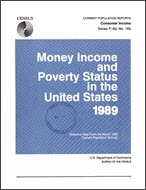
An official website of the United States government
Here’s how you know
Official websites use .gov
A .gov website belongs to an official government organization in the United States.
Secure .gov websites use HTTPS
A lock (
) or https:// means you’ve safely connected to the .gov website. Share sensitive information only on official, secure websites.
-
//
- Census.gov /
- Publications /
- Money Income and Poverty Status in the U.S.: 1989 (Advance Data)
Money Income and Poverty Status in the United States: 1989 (Advance Data From the March 1990 Current Population Survey)
Money Income and Poverty Status in the United States: 1989 (Advance Data From the March 1990 Current Population Survey)
Note
Work experience data contained in tables 4, 10, 14, 15, and 16 are the first to include members of the Armed Forces. This change reflects a modification to the March 1990 income supplement questionnaire in which current Armed Forces members were asked about work experience for the previous calendar year. Tables 1 and 12, however, restrict work experience data to civilians so that year-to-year comparisons are consistent.
Introduction
This report presents data on the income and poverty status of households, families, and persons in the United States for the calendar year 1989. These data were compiled from information collected in the March 1990 Current Population Survey (CPS) conducted by the Bureau of the Census. The survey consisted of approximately 60,000 households nationwide and was designed mainly to produce reliable national estimates, though some data by region and metropolitan residence were also compiled and appear in this report.
The official income and poverty estimates in this report are based solely on money income before taxes and do not include the value of noncash benefits such as food stamps, Medicare, Medicaid, public housing, and employer-provided fringe benefits. For a discussion of the effects of taxes and noncash benefits on income and poverty in 1989, see P-60, No. 169-RD.
The report begins with a section on household income, with year-to-year comparisons by region, type of household, and type of residence. This is followed by a section on changes in family income by race, Hispanic origin, and family composition. Sections on earnings of year-round, full-time workers, per capita income, and income inequality follow the family income section.
Changes in poverty rates and the number of poor are shown for persons by race and Hispanic origin and geographic distribution. Changes in the poverty status of families are displayed by race, Hispanic origin, work experience, and education of householder. There is also a section on the amount of money it would take to raise the incomes of all poor families to their respective poverty thresholds (income deficit).
The report concludes with sections on the trends in money income and poverty status based on two alternate measures of inflation, the CPI-U and CPI-U-X1.
A Note on Language
Census statistics date back to 1790 and reflect the growth and change of the United States. Past census reports contain some terms that today’s readers may consider obsolete and inappropriate. As part of our goal to be open and transparent with the public, we are improving access to all Census Bureau original publications and statistics, which serve as a guide to the nation's history.
Others in Series
Publication
Publication
Publication
Share
Related Information
Some content on this site is available in several different electronic formats. Some of the files may require a plug-in or additional software to view.
 Yes
Yes
 No
NoComments or suggestions?


Top

